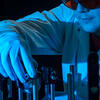Discovery and innovation at the heart of Temple University.
The College of Science and Technology (CST) empowers extraordinary researchers to explore, to discover and to reach into the unknown. Undergraduates gain real-world research experience working with world-class researchers. And graduate students have opportunities to lead investigations, to publish in scientific journals and to make immediate impacts in their fields.
Research that enhances our lives.
Across disciplines, top CST scientists—National Academy members and authors of some of the most-cited scientific publications in history—are advancing research on materials, energy, genomics, molecular science, data science and biodiversity. They helped power Temple University’s rise to R1 status and increased scientific impact as measured by Google Scholar citations.
With six departments, a dozen research centers, multiple undergraduate research opportunities, a growing funded-research budget, technology transfer to today’s marketplace and powerful partnerships across Philadelphia and around the world, CST is a potent engine for discoveries that dramatically improve millions of lives around the world.

